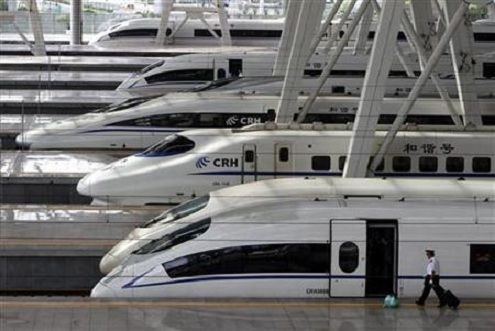Chinese High-Speed Railway Test Promises Fast Access To Xinjiang, Growth, And Stability

In the past, traveling options to China's far-western Xinjiang province have been limited, and often involved arduous journeys. However, a successful test-run of a high-speed rail route promises faster, easier access to the region from provincial capital Urumqi to a network of other Chinese cities.
According to state-run People’s Daily, a test run last week from Urumqi to Shanshan, another city within the province, set out to test the Xinjiang section of the railways. The trial run marks the first part of the railway and the countdown to full operation of the Lanzhou-Urumqi route which is expected to begin by the end of this year. The CRH2-061C train traveled at speeds between 103 to 172 miles an hour (up to 276 km/h).
However, the government has even bigger plans for Xinjiang and the country’s growing web of train lines. When the Xinjiang portion of the railway is completed, it will be able to connect to the country’s already existing train routes, even reaching the country’s biggest cities at unprecedented speeds. According to FarWest China, a Xinjiang-focused blog, traveling at speeds averaging 350 kilometers an hour, or roughly 220 mph, the new high-speed railway will allow travel from Urumqi to Beijing in just 12 hours and from Urumqi to Shanghai in fewer than 20, drastically cutting down travel time for journeys that can currently take 40 to 45 hours.
The Lanzhou-Xinjiang portion of the line required an investment of 143 billion yuan ($23 billion). When the line becomes fully operational it will be the world’s longest high-speed rail track.
Chinese President Xi Jinping has urged strengthened security in the region and around the country after a spate of violent attacks the government blamed on local Uyghur separatists. Part of Xi’s plan for Xinjiang is to help foster long-term stability in the region that has been historically marginalized as a result of its predominantly ethnic Uyghur population.
The new railway is expected to change commerce and tourism for the region. For example, for many in Xinjiang online shopping -- a huge driver of economic growth in China -- is not as convenient as it is for the rest of the country, with mail taking at least a week even while using premium mail carrier services. With the new fast line in operation, trains running on non-high speed rails will be used exclusively for freight, strengthening Xinjiang’s transport abilities and positioning along the Silk Road Economic Belt -- a development corridor that replicates the old trading route of the Silk Road.
© Copyright IBTimes 2024. All rights reserved.




















